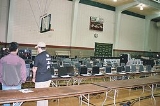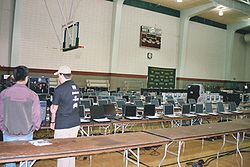
Flash mob computing
Encyclopedia
Flash mob computing is a temporary ad-hoc computer cluster running specific software to coordinate the individual computer
s into one single supercomputer
. A flash mob computer is distinct from other types of computer clusters in that it is set up and broken down on the same day or during a similar brief amount of time and involves many independent owners of computers coming together at a central physical location to work on a specific problem and/or social event.
Flash mob computer derives its name from the more general term flash mob
which can mean any activity involving many people co-ordinated through virtual communities coming together for brief periods of time for a specific task or event. Flash mob computing is a more specific type of flash mob for the purpose of bringing people and their computers together to work on a single task or event.
 The first flash mob computer was created on April 3, 2004 at the University of San Francisco
The first flash mob computer was created on April 3, 2004 at the University of San Francisco
using software written at USF called FlashMob (not to be confused with the more general term flash mob
). The event, called FlashMob I, was a success. There was a call for computers on the computer news website Slashdot
. An article in the NY Times "Hey, Gang, Let’s Make Our Own Supercomputer" brought a lot of attention to the effort. More than 700 computers were brought to the gym at the University of San Francisco and were wired to a network
donated by Foundry Networks
. At FlashMob I they were able to run a benchmark on 256 of the computers and achieved a peak rate of 180 Gflops
(billions of calculations per second), although this computation stopped three quarters of the way through due to a node failure. The best, complete run used 150 computers and resulted in 77 Gflops. FlashMob I was run off a bootable CD-ROM that ran a copy of Morphix Linux
and was only available for the x86 platform.
Despite these efforts, the project was unable to achieve its original goal of running a cluster momentarily fast enough to enter the (November 2003) Top 500 list of supercomputers. The system would have had to provide at least 402.5 Gflops to match a Chinese
cluster of 256 Intel Xeon
nodes. For comparison, the fastest super computer at the time, Earth Simulator
, provided 35860 Gflops.
Greg Benson, USF Associate Professor of Computer Science, invented the name "flash mob computing", and proposed the first idea of wireless flash mob computers. Greg worked on the core infrastructure of the FlashMob run time environment.
John Witchel (Stuyvesant High School
'86) was a USF graduate student in Computer Science during the Spring of 2004. After talking to Greg about the issues of networking a stadium of wireless computers and listening to Pat lecture on what it takes to break the Top 500, John asked the simple question: "Couldn't we just invite people off the street and get enough power to break the Top 500?" And flash mob supercomputing was born. FlashMob I and the FlashMob software was John's master's thesis.
Computer
A computer is a programmable machine designed to sequentially and automatically carry out a sequence of arithmetic or logical operations. The particular sequence of operations can be changed readily, allowing the computer to solve more than one kind of problem...
s into one single supercomputer
Supercomputer
A supercomputer is a computer at the frontline of current processing capacity, particularly speed of calculation.Supercomputers are used for highly calculation-intensive tasks such as problems including quantum physics, weather forecasting, climate research, molecular modeling A supercomputer is a...
. A flash mob computer is distinct from other types of computer clusters in that it is set up and broken down on the same day or during a similar brief amount of time and involves many independent owners of computers coming together at a central physical location to work on a specific problem and/or social event.
Flash mob computer derives its name from the more general term flash mob
Flash mob
A flash mob is a group of people who assemble suddenly in a public place, perform an unusual and sometimes seemingly pointless act for a brief time, then disperse, often for the purposes of entertainment, satire, artistic expression...
which can mean any activity involving many people co-ordinated through virtual communities coming together for brief periods of time for a specific task or event. Flash mob computing is a more specific type of flash mob for the purpose of bringing people and their computers together to work on a single task or event.

University of San Francisco
The University of San Francisco , is a private, Jesuit/Catholic university located in San Francisco, California. Founded in 1855, USF was established as the first university in San Francisco. It is the second oldest institution for higher learning in California and the tenth-oldest university of...
using software written at USF called FlashMob (not to be confused with the more general term flash mob
Flash mob
A flash mob is a group of people who assemble suddenly in a public place, perform an unusual and sometimes seemingly pointless act for a brief time, then disperse, often for the purposes of entertainment, satire, artistic expression...
). The event, called FlashMob I, was a success. There was a call for computers on the computer news website Slashdot
Slashdot
Slashdot is a technology-related news website owned by Geeknet, Inc. The site, which bills itself as "News for Nerds. Stuff that Matters", features user-submitted and ‑evaluated current affairs news stories about science- and technology-related topics. Each story has a comments section...
. An article in the NY Times "Hey, Gang, Let’s Make Our Own Supercomputer" brought a lot of attention to the effort. More than 700 computers were brought to the gym at the University of San Francisco and were wired to a network
Computer network
A computer network, often simply referred to as a network, is a collection of hardware components and computers interconnected by communication channels that allow sharing of resources and information....
donated by Foundry Networks
Foundry Networks
Foundry Networks, Inc. was a networking hardware vendor selling high-end Ethernet switches and routers. The company was founded in 1996 by Bobby R. Johnson, Jr. and was headquartered in Santa Clara, California, USA...
. At FlashMob I they were able to run a benchmark on 256 of the computers and achieved a peak rate of 180 Gflops
FLOPS
In computing, FLOPS is a measure of a computer's performance, especially in fields of scientific calculations that make heavy use of floating-point calculations, similar to the older, simpler, instructions per second...
(billions of calculations per second), although this computation stopped three quarters of the way through due to a node failure. The best, complete run used 150 computers and resulted in 77 Gflops. FlashMob I was run off a bootable CD-ROM that ran a copy of Morphix Linux
Linux
Linux is a Unix-like computer operating system assembled under the model of free and open source software development and distribution. The defining component of any Linux system is the Linux kernel, an operating system kernel first released October 5, 1991 by Linus Torvalds...
and was only available for the x86 platform.
Despite these efforts, the project was unable to achieve its original goal of running a cluster momentarily fast enough to enter the (November 2003) Top 500 list of supercomputers. The system would have had to provide at least 402.5 Gflops to match a Chinese
China
Chinese civilization may refer to:* China for more general discussion of the country.* Chinese culture* Greater China, the transnational community of ethnic Chinese.* History of China* Sinosphere, the area historically affected by Chinese culture...
cluster of 256 Intel Xeon
Xeon
The Xeon is a brand of multiprocessing- or multi-socket-capable x86 microprocessors from Intel Corporation targeted at the non-consumer server, workstation and embedded system markets.-Overview:...
nodes. For comparison, the fastest super computer at the time, Earth Simulator
Earth Simulator
The Earth Simulator , developed by the Japanese government's initiative "Earth Simulator Project", was a highly parallel vector supercomputer system for running global climate models to evaluate the effects of global warming and problems in solid earth geophysics...
, provided 35860 Gflops.
Creators of flash mob computing
Pat Miller was a research scientist at a national lab and adjunct professor at USF. His class on Do-It-Yourself Supercomputers evolved into FlashMob I from the original idea of every student bringing a commodity CPU or an Xbox to class to make an evanescent cluster at each meeting. Pat worked on all aspects of the FlashMob software.Greg Benson, USF Associate Professor of Computer Science, invented the name "flash mob computing", and proposed the first idea of wireless flash mob computers. Greg worked on the core infrastructure of the FlashMob run time environment.
John Witchel (Stuyvesant High School
Stuyvesant High School
Stuyvesant High School , commonly referred to as Stuy , is a New York City public high school that specializes in mathematics and science. The school opened in 1904 on Manhattan's East Side and moved to a new building in Battery Park City in 1992. Stuyvesant is noted for its strong academic...
'86) was a USF graduate student in Computer Science during the Spring of 2004. After talking to Greg about the issues of networking a stadium of wireless computers and listening to Pat lecture on what it takes to break the Top 500, John asked the simple question: "Couldn't we just invite people off the street and get enough power to break the Top 500?" And flash mob supercomputing was born. FlashMob I and the FlashMob software was John's master's thesis.
External links
- San Francisco Flashmob Attempts Supercomputer Original Slashdot article
- FlashMobComputing.org

